Home Run by the Home Team
Covid-19 Vaccine Debuts at Clinical Center
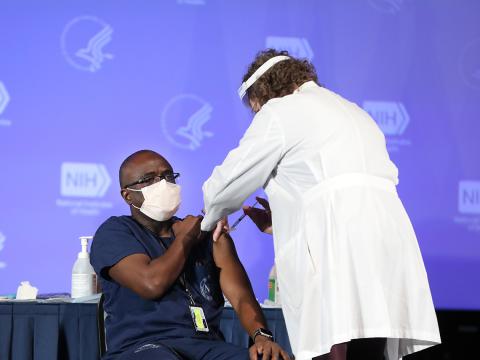
Photo: Chia-Chi Charlie Chang
Three days before Christmas, 6 Clinical Center health care workers became the first recipients of the Moderna Covid-19 vaccine that was pioneered by NIAID scientists and industry partners in the precedent-shattering speed of only 11 months.
They were followed onstage at the historic vaccination event in Masur Auditorium by HHS Secretary Alex Azar II, NIAID director Dr. Anthony Fauci, NIH director Dr. Francis Collins and Colleen McGowan, director of the Office of Research Services, who emceed the 40-minute ceremony that was broadcast virtually.
The vaccine produced an immediate reaction in nearly all of the 10 recipients—broad smiles and the thumbs-up gesture.
“Good morning to all of you on this historic day,” said Collins at the beginning of the event, noting the velocity with which the vaccine was produced—the Covid-19 pandemic didn’t arrive on most scientists’ radar until January 2020.
“Many prayers have been lifted up, over this terribly difficult year, that an answer to this global pandemic might emerge from the dedicated work of our scientists…I will admit that quite a few of those prayers were mine,” he said. “It is with great pride, joy and gratitude that I stand here today, awaiting the historic moment when the first frontline health care workers at NIH, along with a few of our nation’s public health leaders, will receive their first dose of a Covid-19 vaccine.”
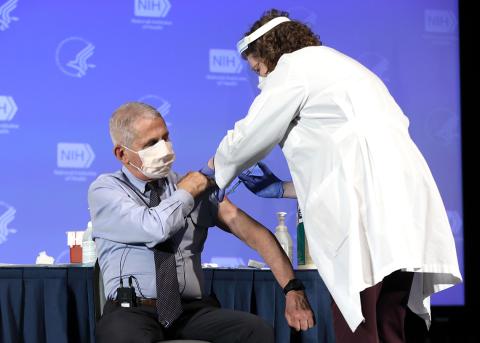
Photo: Chia-Chi Charlie Chang
He noted that the mRNA technology that forms the basis of both the Moderna vaccine and the Pfizer/BioNTech product “rests on fundamental research conducted right here at NIH, at our Vaccine Research Center.” He called Fauci “an absolutely vital leader in this effort” and assured the small crowd gathered in Masur Auditorium that, if not for the distancing required by the pandemic, “the audience would be packed with scientists rising to their feet and cheering for Tony’s leadership in science and in public communication.”
“I am very pleased and honored to be here,” said Fauci, who recalled his first meeting in Masur Auditorium in the summer of 1968, when he arrived “at this extraordinary place we’re in right now” for fellowship training.
“This is the culmination of years of research which have led to a phenomenon that has truly been unprecedented,” he noted. “And that is to go from a realization that we’re dealing with a new pathogen—a virus that was described in January of this year—to less than one year later [having] vaccines that are going into the arms of so many people, including myself.”
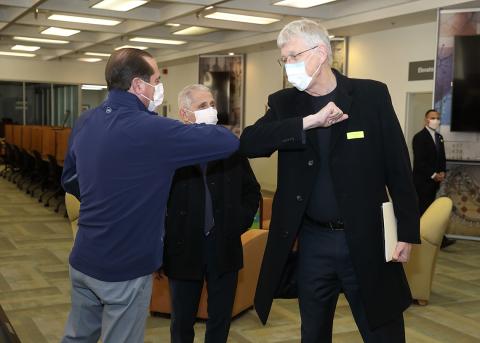
Photo: Chia-Chi Charlie Chang
“This is a proud and happy occasion,” said Azar, adding that he is a patient at the Clinical Center. “We’ve all said it is nothing short of miraculous to have a safe and effective vaccine within one year of a novel virus becoming known to the world. But when we need a medical miracle, we know where to look…[The vaccine] will save thousands and thousands of lives and help bring this dark chapter to an end. In the long and storied history of the NIH, this is one of your finest accomplishments.”
Azar said his role in Operation Warp Speed, which supported vaccines and therapies for Covid-19, will be one of his proudest memories, an example of the importance of thinking big when it comes to the mission of public health.
“This is more or less like any other vaccine we receive, like the annual flu shot,” he continued, assuring the audience that no corners were cut in its evaluation and production. “Americans can be confident in this vaccine, and in any others that are authorized by the Food and Drug Administration…On behalf of a grateful country, thank you for your work at NIH this year.”
The first person to receive the vaccine, administered by Dr. Heike Bailin, acting director of the Occupational Medical Service, assisted by nurse Julie Chan, was Ebenezer Mienza, a respiratory therapist at the CC for 23 years. Next came Carline Samedy, a nurse with 15 years at the CC; Dr. Jeffrey Strich, a PHS officer and critical care physician; Therese Kent, a nurse practitioner in critical care; Dr. Neelam Giri, a staff physician in NCI’s Clinical Genetics Branch who works at the outdoor car line station for those with symptoms of Covid-19; and finally Naomi Richardson, a CC nurse who takes care of Covid-19 patients.
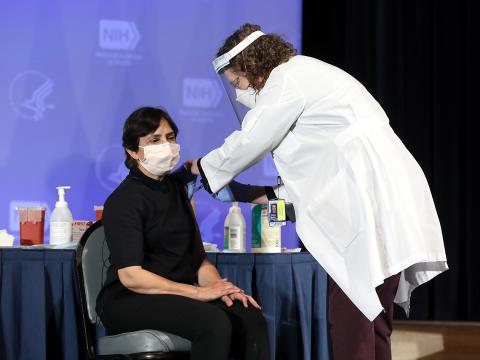
Photo: Chia-Chi Charlie Chang
When Fauci stepped up for vaccination, offering a date of birth indicating he was only 2 days shy of his 80th birthday, he said two reasons motivated him: “One, I’m an attending physician here…and so I do see patients, but as important or more important is as a symbol to the rest of the country that I feel extreme confidence in the safety and the efficacy of this vaccine, and I want to encourage everyone who has the opportunity to get vaccinated so that we can have a veil of protection over this country that would end this pandemic.”
Up next, in a black T-shirt reminiscent of his appearances as a guitarist in his multiple bands, was Collins.
“It’s an incredible privilege to serve as director of the National Institutes of Health,” he began. “I get to talk a lot about these vaccines and their promise for ending this terrible global pandemic. But it’s one thing to hear me talk about it; it’s another to have me roll up my sleeve and say I believe that this is the way we’re going to get through this. This is something that the evidence has shown, in rigorous scientific analysis, to be safe and effective, so I’m rolling up my sleeve and I’m saying, ‘Dr. Bailin, bring it on!’”
The injection done, he quipped, “Are you done yet? That was no problem, people.”
The final recipient was McGowan, a mother of two who said, “It’s important as a mom to show other mothers how safe this is. I also want to chronicle this on Facebook, to show my naysayer friends that this vaccine is safe and effective.”
After a 28-day interval, all of the vaccine recipients will return for their second dose of the product known as mRNA 1273.
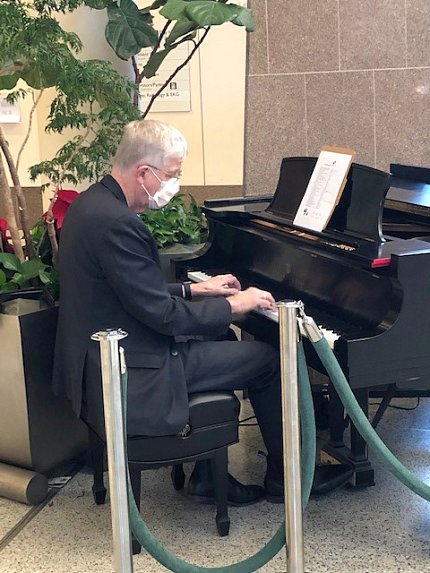
Photo: John Burklow
Wrapping up the ceremony, Collins called the day “yet another profoundly significant moment” in the 67 years that the Clinical Center has served as “the House of Hope…It is deeply gratifying to have these halls at NIH now take part in the light that is starting to appear at the end of a long, dark tunnel called Covid-19, a light made possible by NIH science and our many partners.”
Before wishing everyone a happy and healthy holiday season, he quoted a Bible verse, a poem by King David recorded as Psalm 103:
Bless the Lord, O my soul,
And forget not all His benefits:
Who forgives all your iniquities,
Who heals all your diseases,
Who redeems your life from the pit,
Who crowns you with steadfast love
and mercy,
Who satisfies you with good,
So that your youth is renewed like the eagle’s.
Bless the Lord, oh my soul.
“And the people all said amen.”
The complete event is available at https://videocast.nih.gov/watch=41273.
